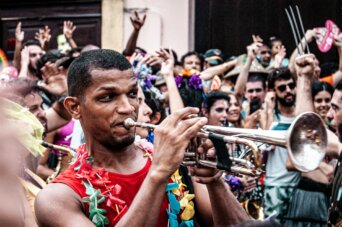- About
- Topics
- Story
- In-Depth
- Picks
- Opinion
- News
- Donate
- Signup for our newsletterOur Editors' Best Picks.Send
Read, Debate: Engage.
| topic: | Freedom of Expression |
|---|---|
| located: | Brazil |
| editor: | Ellen Nemitz |
The internationally famous Brazilian Carnival attracts thousands of tourists every year to enjoy a colourful and happy parade, in both Rio de Janeiro and São Paulo. This festival, however, is also a way of talking about politics.
This is no novelty this year since it has often been a political platform already before. Samba schools, which send a float to the parade, were born in poor communities in the first place and serve to represent the unity of these people around a big celebration. Historical plots include the criticism of dictatorship regimes, the representation of social inequality and numerous historic Brazilian moments. Year after year, politics makes its big entrance in one of the most famous parties in the world: art imitating life.
To the BBC, the historian Luiz Antônio Simas and the journalist Fábio Fabato defined Carnival as a textbook for a population without books - alluding to the Cold War period. Nowadays, Pedro Borges, an award-winning writer and the editor of Alma Preta Jornalismo (an outlet made by and for black people) assesses that while Carnival "imposes a debate on racism and inequality in society" and forces the press to "talk about religions of African origin,” it is attacked by those who want to diminish these topics.
In 2022, however, the celebration had a different taste: this out-of-season Carnival may sound strange to some, while a catharsis for many others, after the cancellation of the 2021 edition and the postponement of this year's original date due to a pandemic that killed more than 650,000 people in the country.
An actor playing Jair Bolsonaro, the controversial far-right president in office since 2019 and running for re-election in October 2022, artistically became an alligator in one of the dozens of parades after receiving a jocose vaccination that, in the end, is a deep criticism of his denialism over the pandemic. The black lives resistance and the struggles of this population in a racist country were also present themes in several plots. Indigenous peoples, as well, were not only represented or honoured; they were actually present and celebrated the moment.
"A carnival of fights," Sônia Guajajara, one of the most prominent Brazilian indigenous leaders, defined the celebration after participating in two parades in São Paulo along with many other pairs - including relatives of Cacique Raoni, another great name of the indigenous movement. She was one of the highlights of an allegorical parade float suggesting the retaking of power by indigenous peoples.
Many parades also brought up the African religious theme to the public, in a carnival that is being called by some black influencers the most "macumbeiro" of all - the Portuguese word is usually used to offend people following these religions, but here it is reclaimed and used in a positive way. Besides, problems like the return of hunger - portrayed with the sculpture of a malnourished and skeletal child eating a plate of bones - and the importance of taking care of our water were also chosen subjects; nature was also respected by the gradual overcoming of the use of real feathers for cruelty-free options in the costumes.
If Carnival sings the wounds and joys of Brazil, may the next editions tell a different and happier story.
Image by Ferran Feixas

